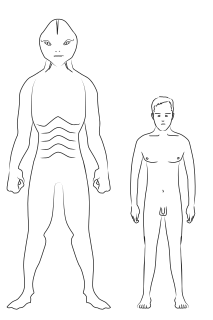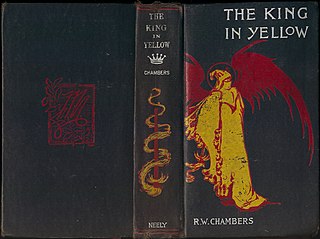
The Cthulhu Mythos is a shared fictional universe, originating in the works of American horror writer H. P. Lovecraft. The term was coined by August Derleth, a contemporary correspondent and protégé of Lovecraft, to identify the settings, tropes, and lore that were employed by Lovecraft and his literary successors. The name Cthulhu derives from the central creature in Lovecraft's seminal short story, "The Call of Cthulhu", first published in the pulp magazine Weird Tales in 1928.

Cthulhu is a fictional cosmic entity created by writer H. P. Lovecraft and first introduced in the short story "The Call of Cthulhu", published in the American pulp magazine Weird Tales in 1928. Considered a Great Old One within the pantheon of Lovecraftian cosmic entities, the creature has since been featured in numerous popular culture references. Lovecraft depicts Cthulhu as a gigantic entity worshipped by cultists. Cthulhu's appearance is described as looking like an octopus, a dragon, and a caricature of human form. Its name was given to the Lovecraft-inspired universe where it and its fellow entities existed, the Cthulhu Mythos.

Shub-Niggurath, often associated with the phrase “The Black Goat of the Woods with a Thousand Young”, is a deity in the Cthulhu Mythos of H. P. Lovecraft. The only other name by which H. P. Lovecraft referred to her was "Lord of the Wood" in his story The Whisperer in Darkness.

Nyarlathotep is a character in the works of H. P. Lovecraft and other writers. The character is commonly known in association with its role as a malign deity in the Lovecraft Mythos fictional universe, where it is known as the Crawling Chaos. First appearing in Lovecraft's 1920 prose poem of the same name, he was later mentioned in other works by Lovecraft and by other writers and in the tabletop role-playing games making use of the Cthulhu Mythos. Later writers describe him as one of the Outer Gods.

Azathoth is a deity in the Cthulhu Mythos and Dream Cycle stories of writer H. P. Lovecraft and other authors. He is the ruler of the Outer Gods.

Deities & Demigods, alternatively known as Legends & Lore ,) is a reference book for the Dungeons & Dragons fantasy role-playing game (D&D). The book provides descriptions and game statistics of gods and legendary creatures from various sources in mythology and fiction, and allows dungeon masters to incorporate aspects of religions and mythos into their D&D campaigns.
De Vermis Mysteriis, or Mysteries of the Worm, is a fictional grimoire created by Robert Bloch and incorporated by H. P. Lovecraft into the lore of the Cthulhu Mythos.
Lovecraftian horror is a subgenre of horror fiction that emphasizes the cosmic horror of the unknown more than gore or other elements of shock. It is named after American author H. P. Lovecraft (1890–1937), who is largely credited as the first author to pioneer the genre.

"Dagon" is a short story by American author H. P. Lovecraft. It was written in July 1917 and is one of the first stories that Lovecraft wrote as an adult. It was first published in the November 1919 edition of The Vagrant. Dagon was later published in Weird Tales. It is considered by many to be one of Lovecraft's most forward-looking stories.
The following tables and lists feature elements of the Cthulhu Mythos, that are often shared between works within that fictional setting.
The Xothic legend cycle is a series of short stories by American writer Lin Carter that are based on the Cthulhu Mythos of H. P. Lovecraft, primarily on Lovecraft's stories "The Call of Cthulhu" and "Out of the Aeons".
K'n-yan is a fictional, subterranean land in the Cthulhu Mythos. The underground realm was first described in detail in H. P. Lovecraft's revision of Zealia Bishop's The Mound (1940), in which it is discovered by the 16th century Spanish Conquistador Zamacona. Lovecraft also mentions K'n-yan in The Whisperer in Darkness (1930) and in his revision of Hazel Heald's "Out of the Aeons" (1935). The people of K'n-yan are sometimes referred to as the "Old Ones", a term of variable meaning in Lovecraft's fiction.
"The Horror at Red Hook" is a short story by American writer H. P. Lovecraft. Written on August 1–2, 1925, it was first published in the January 1927 issue of Weird Tales.
Figures from Aztec mythology have appeared many times in works of modern culture.
Serpent Men are a fictional race created by Robert E. Howard for his King Kull tales. They first appeared in "The Shadow Kingdom," published in Weird Tales in August 1929.
H. P. Lovecraft created a number of deities throughout the course of his literary career, including the "Great Old Ones" and aliens, such as the "Elder Things", with sporadic references to other miscellaneous deities whereas the "Elder Gods" are a later creation of other prolific writers such as August Derleth, who was credited with formalizing the Cthulhu Mythos.





















